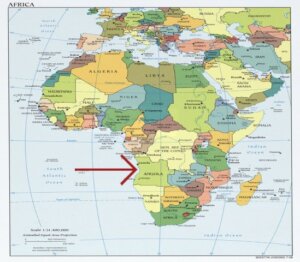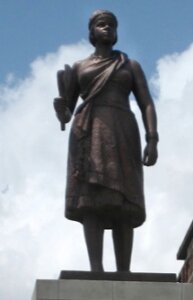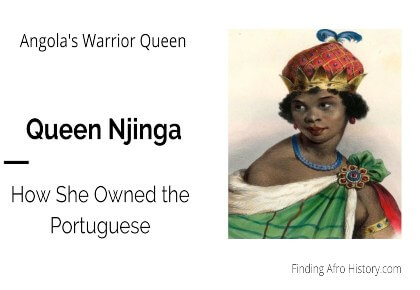Queen Njinga the Warrior Queen: How She Handled the Portuguese
Name Variations: Njinga, Nzinga, Ana de Sousa Nzingha Mbande
(1582-1663)
Queen Njinga, the warrior queen, with technique, heroism, and pressure, led her fighters in military crusades against Portuguese invaders. She was born in 1582 in Central Africa’s Kingdom of Ndongo. Prior to becoming queen, her grandfather, dad, and brother each at one point ruled the nation even as the Portuguese continued their efforts to dominate the region.
Portuguese Invade the Kongo
In 1575, Paulo Dias de Novais arrived at the port of Luanda. He brought with him a military fleet of a thousand men and a few priests. The King of Portugal instructed Novais to gain jurisdiction of the kingdom of Angola, and the church of Portugal blessed Dias de Novais’ mission to establish a Portuguese slave market in Angola.
Before becoming queen, Njinga would have to follow in the footsteps of her grandfather Ngola Kilombo Kia Kasenda (1575-1592), who also resisted Portuguese invasion. He fought many battles to keep the Portuguese out of his territories. He lost some battles, but those he won dealt impressive and crushing blows to the Portuguese army and African kingdoms that sided with the Portuguese.
Rise of Queen Njinga
From 1592 to 1617, Njinga’s father Mbande a Ngola Kiluanje ruled the kingdom. Like her grandfather, Njinga’s father spent many days on the front line defending his kingdom against the Portuguese. When not at war, Njinga’s father trained his little girl to fight as a soldier and think like a man.
From 1617 to 1624, Njinga’ s brother Ngola Mbande (named after their father) ascended to the throne. In 1622, seeking a peace treaty with the Portuguese, he asked Njinga to negotiate the terms on his behalf.
With a royal procession of attendants, military entourage, good looks, and sharp negotiating techniques, Njinga journeyed to Luanda to meet with the Portuguese governor. The governor was a cocky individual. He presented himself to Njinga from a regal chair and a piece of cloth or rug rested on the floor for her to sit. Being of royal descent, and a proud African woman of the Mbundu people, there was no way Njinga would sit at his feet.
Insulted by the governor’s attitude. Njinga beckoned for one of her attendants to approach. As the attendant approached, she kneeled and formed her body into the shape of a bench. Njinga then sat across the back of the attendant. Now, sitting eye to eye with the governor, she negotiated the terms of the treaty. Satisfied with the conclusion, as dignified as she arrived, she left in the same manner.
Warrior Queen Assembles Military
In 1626, Njinga’s brother died. The Portuguese refused to continue honoring the treaty. Influential noblemen challenged Queen Njinga’s claim. This is when the Portuguese pressured the noblemen to reject Njinga’s claim to the throne.
The Portuguese slave-trading operation relied on African rulers they could intimidate and control. The Portuguese had a reputation for capturing and murdering African people and cutting off their noses as trophies. For the Portuguese to continue brutalizing the African people, they needed a puppet ruler on the throne. Queen Njinga would not become that puppet. Fearing assassination, Njinga fled the state of Ndongo.
Pissed off to the highest level of anger, she would unleash hell on the Portuguese and anyone who stood in her way.
Queen Njinga, Rolls-Out Intellectual Warfare:
- Njinga conquered the nearby Kingdom of Matamba as her capital city, appointed herself as Queen, created a safe refuge for slaves seeking to liberate themselves, and set up military training for the women. Church missionaries were treated as spies and denied entry into her territory.
- Reduced Portuguese fighting forces by persuading Portuguese slave soldiers to join her military
- Launched a media blitz befitting for her time, by getting the word out that the Portuguese was an untrustworthy group of evil and wicked people.
- Volunteered to convert to Christianity, learned all she could about how Christians thought and behaved, used their belief system to her advantage.
- Created an alliance with one of the fiercest tribes in the region, the Imbangala people. Their rituals and war tactics were unconventional. Apparently, her fight against the Portuguese provided the Imbangala’s a steady supply of “appetizers & entrees” (LOL) which was a win-win-situation for Queen Njinga!
- Secured an alliance with the Dutch, further expanding her ability to resist the Portuguese.
Queen Njinga’s influence grew in power and popularity. Portuguese soldiers trembled with fear at the thought of fighting against her military. Her warriors owned the battlefield. They annihilated the Portuguese.


30 Year War with Portugal
To maintain her kingdom’s independence from colonialism, she remained in a constant battle with the Portuguese. She escaped and evaded Portuguese capture. As quickly as she lost territory, she recovered it with brute force. Queen Njinga’s Kingdoms of Ndongo-Matamba was a commercial superpower. The warrior queen was constantly surrounded by invading Portuguese and domestic enemies. Steadfast in her fight to protect and maintain the freedom of her Ndongo-Matamba territories, she relentlessly harassed and targeted Portuguese slave-trading posts. Over time, she had an army of 80,000 men and women.
Queen Njinga’s Legacy
On the battlefield, Queen Njinga the Warrior Queen fought side by side with her soldiers. Throughout her reign, she supported a fighting force of over 80,000 men and women. She maintained leadership and applied the full force of her strength and energy with every blow.
Off the battlefield, her diplomacy and political savvy kept her several steps ahead of the Portuguese.

On December 17, 1663, at eighty-one, Queen Njinga died undefeated. Her funeral was a royal affair. Over a thousand men, women, and children escorted her body. They dressed her in royal regalia. The military band comprised nearly one hundred people. She outlived a dozen different Portuguese governors;…“now the twenty thousand soldiers and others had gathered in the plaza to view the corpse of their queen, to see Njinga for one last time” (Heywood, 2019).
Learn More
Power Sessions with Natasha https://youtu.be/pp5W3Whwxho
Humble History https://youtu.be/ATAV3nYIPmI
Image: Erik Cleves Kristensen 2009, Luanda, Republic of Angola, Queen Njinga Statue
1 Map By Nerika – Own work, CC BY-SA 3.0, https://commons.wikimedia.org/w/index.php?curid=25352805\
2 Map https://pixy.org/467786/
(red arrows added to maps to help the reader identify territories mentioned in the post)
Works Cited:
Heywood, Linda M. 2019. Njinga of Angola. Cambridge: Harvard University Press.
References:
Heywood, Linda M. 2019. Njinga of Angola. Cambridge: Harvard University Press.
Thornton, John K. 1991. “Legitimacy and Political Power: Queen Njinga, 1624-1663.” The Journal of African History vol.30 no.1 25-40.
Thornton, John K. 1988. “The Art of War in Angola, 1575-1680.” Comparative Studies in Society and History vol. 30 no.2 360-378.

